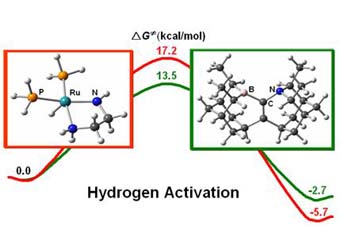A strategy to design metal-free hydrogen activation site has been computationally formulated by Wang’s group. Based on their so-called Pi-FLPs (Frustrated Lewis Pair) strategy, they first hypothesized that a more reactive activation site should arrange the nitrogen lone pair and the boron vacant orbital to lie in the same plane fact-to-face, because such orbital orientations can simultaneously enhance the interaction between nitrogen lone pair and the H
2 σ* antibonding orbital and the interaction between the boron vacant orbital and the H
2σ bonding electrons. To verify such active site achievable, we then computationally designed molecules and studied their reactions with hydrogen. The energetic results show the designed molecules are indeed more reactive than the sp3 carbon bridged FLPs. Some of the hydrogen activations reach the kinetics and thermodynamics comparable with those of the hydrogen activations mediated by the well-known metal-ligand bifunctional hydrogenation catalysts. The designed molecules could be the targets for experimental synthesis. The pattern of the proposed active site can be based to design similar molecules for metal-free hydrogenations.
The related results were published by Inorganic Chemistry (
Inorg. Chem. 2010, 49, 295).
